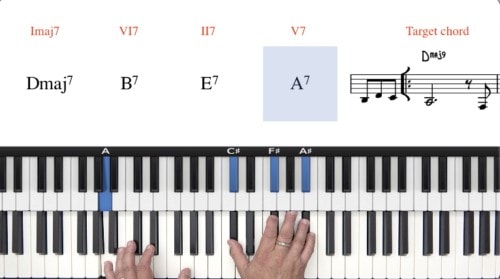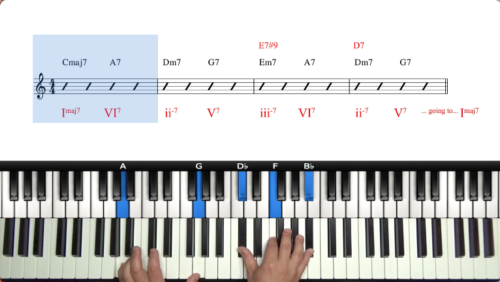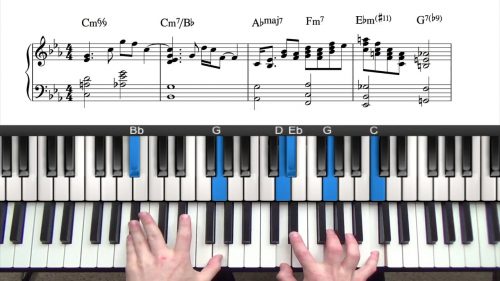Minor Introductions & 1625s
Welcome to this tutorial on solo piano introductions for tunes in minor keys. In other lessons have explored some useful formulas that can be used to create intros for tunes in major keys. You can find links to these tutorials in the related lessons below.
“My Funny Valentine”
We will now take the tune My Funny Valentine which starts with a C-7 chord and we will explore some different techniques that we can use to create solo piano introductions.
Finishing on the V7 Chord.
Perhaps the most important aspect of an introduction is leading into the 1st chord of the tune with its V7 chord.
“My Funny Valentine” starts with a C-7 chord and so the V7 would be a G7. In minor keys, we often alter the V7 chord by adding alterations and tensions. We explore some example G7alt voicings that we can use.
Creating a 25 Progression
Every V7 chord can be approached by its ii-7 chord. In minor keys, the ii-7 chord is often played with a b5. For a 251 in C Minor, we would have D-7b5, G7alt, and C-7.
We explore some interesting voicings for this progression and how this can create a simple but effective introduction.
Adding the IV Chord
We can extend the 251 progression to create a 1625 progression. We have a few options here with the chords we choose to play. The 1 chord can be a ‘vanilla’ C-7 chord, or we can play a C-maj7 for a different minor ‘flavour’.
The VI chord can be either an Abmaj7, or an A7alt. Both are effective and create a different character to the introduction. The A7 creates a stronger sense of resolution into the the ii-7b5 chord, but the Abmaj7 chord is also a nice option for adding variety and interest to the progression.
Vamp Between The i-7 and VImaj7 chord
It can be nice to vamp between the i-7 chord and the VImaj7 chord in any minor key. These 2 chords have similarities in their associated chord scales and vamping between them creates an interesting texture for an introduction.
We vamp between these 2 chords and the inversions and when we are ready we hit the 25 progression to take us into the form.
Using the Harmony of the Tune
Often the best source of inspiration for an introduction is the tune itself. If we analyse the harmony of the first 8 bars of “My Funny Valentine” we can see that it contains all of the chords we have covered. In addition we now have an F-7. The A section also ends on a G7 chord which will lead us smoothly and convincingly into the first chord of the tune.
Lesson Downloads
-
Minor Introductions Lesson Notation File Type: pdf
Practice Tips
-
Understand the importance of the V7 chord as the final point of our introduction.
-
Learn and memorise a selection of V7alt voicings which can be used to end our introductions and lead us smoothly into the start of the form.
-
Experiment with the minor 1625 progression and its variations.
-
Take a minor tune in a different key and work out the voicings for a i-7 to VImaj7 vamp and the 25 progression into the first chord of the tune.
-
Try to create your own introductions based on the harmony of the A section. This technique can be applied to any tune with an AABA form.
-
Apply the minor 1625 as a turnaround and use this to transition into an improvised solo.








Simply blown away by this lesson! Hayden – Thank you for always allowing and leading us to explore and push ourselves more :) Love every bit of this lesson! The improvisation and turnarounds! – WoW! am all smiles! Thank you! I have a TON to learn haha… but will surely be having FUN!
Thanks Tina, I’m very happy to hear you enjoyed it.
After reading you email, and seeing your performance, it gave me lots of ideas for this lesson so thank you!
Very happy to hear you like it :-)
Hayden
it’s so quick for you to simply improvise and make variations during song parts and the in between’s -that’s really admirable! the possibilities seem vast.. i love it – I’ll be really making some time for theory lessons – chords and progressions .. 9:45mark onwards – wow – one of my favourites.! Will post in here next time in case I have a question :D Thank you Hayden!
That all comes with time Tina.
Everything I play, whether it’s a variation/ornamentation on the melody, or an improvised section, it’s all based on the recordings I have listened too, studied, and transcribed. Those sounds/shapes/lines/licks/rhythms etc… are in my head from listening and studying them, which then allows me to execute them on demand
As we discussed over email, this is the ultimate source of inspiration. Spend an hour a day listening and trying to work it out things you like with your ears, and in a year’s time, you will be amazed with the results.
Stay safe and talk soon :–)
Hayden
What a great lesson! These intros are so fun
Thanks Oliver – glad you enjoyed the lesson.
Here are some related lessons which you might enjoy:
Solo Piano Introductions with Jovino: pianogroove.com/bossa-nova-lessons/creating-solo-piano-introductions/
Solo Piano Introductions with Tuomo: pianogroove.com/jazz-piano-lessons/solo-piano-introductions-tips-tricks/
Cheers!
Hayden
Please some lessons on gospel piano.
Thanks,
a long time student of piano groove,
Michael
Hi Michael 👋🏻
We have signed and agreed a course and series of live seminars with a very famous gospel pianist.
I will send you some more information on this now via email.
Cheers,
Hayden
This sounds fanastic in a minor key. Can this same intro pattern in a major key work just as well? Or is there something about minor tones and minor progressions that make this sound so great?
Also, is this covered in other Keyes somewhere? I’m working on applying it in a few other keys but it would be great to have a guide of some kind…
Hi Marla,
I’m glad you enjoyed the lesson. Please excuse my late reply here.
These progressions work slightly differently in major keys, you might like to check out the following 2 lessons which cover major 1625 and 3625 variations:
pianogroove.com/jazz-piano-lessons/1625-436251-progressions/
pianogroove.com/jazz-piano-lessons/jingle-bells-1625-improv/ (more bluesy vibe)
pianogroove.com/jazz-piano-lessons/beautiful-chord-progression/
For demonstrations in other keys, I don’t believe we have these currently but I am hosting a seminar next week on minor improvisation and so we can definitely cover this and apply to 3 minor tunes. You can add the seminar to you calendar and register for updates here:
pianogroove.com/live-seminars/minor-key-improvisation/
Hope to see you there!
Cheers,
Hayden
Thanks for this and the many, many helpful and productive lessons. As you’ve often recommended, I’m trying to apply this to other songs. Would you please help me work out application of the formula above (1625 in C Minor for a song that starts on Cm) to a song in Gm (e.g., Autumn Leaves, or is it key of Bb maj?) that starts on the 4 chord (not certain of that either… is it the 2 chord of Bb maj or the 4 chord of Gm?) I’m guessing it might conclude with Dm-G7alt to the Cm… Would the vamp be between Gm and Eb? Or do I have this completely out of whack? Thanks in advance for your help!
Hi Michael 👋
Great question here!
This introduction formula works well for tunes in minor keys that start on the 1 chord. Another example would be “In A Sentimental Mood” which is in the key of D Minor and starts on a D minor triad.
For the tune “Autumn Leaves”, you are correct that the tune is written in the key of G Minor (we can usually decipher the key of a tune by the final chord in the form where the tune is supposed to resolve, in this case G-7). For “Autumn Leaves”, the tune starts on the ii-7 chord of the relative minor key (Bb Major) which is not a common starting point for jazz standards.
You could still use the progressions that we cover in this lesson (which lead to C Minor). From a harmonic standpoint this works fine to lead us into the to C-7 chord, but the chords that we are using are from the key of C minor.
The simplest way to create an introduction is to play the harmony of the tune.
For the tune “Autumn Leaves” it’s common to play a G7 in bar 8 of the form, which then creates a dominant V-I cadence into the C-7 to start the A section again.
You could play an introduction with the following: A-7 to D7 to G-7 to G7 —> moving to C-7
Alternatively you can stretch this out and play the whole A section harmony as an introduction which would be C-7 to F7 to Bbmaj7 to Ebmaj7 to A-7b5 to D7 to G-7 and finally G7 which sets up the C-7 to start the tune.
I would recommend to start with the first option which is a 251 in G Minor (the key of the tune) and then a G7 passing chord which sets up the C-7. That way the harmony of your introduction is rooted in the key of the tune and you can perhaps play an altered G7 voicing with some upper structures to add a little tension and dissonance to set up the C-7 chord.
So you could have:
A-7 or A-7b5 –> D7 (altered? or USTs?) –> G-7 (G-6 or G-69 also works beautifully) and then to the G7 (I like to play a #5#9 voicing)
Remember you can also play the tritone subs:
A-7 to Ab7 to G-7 to Db7 –> leading to C-7
All we are really playing here is a 251 in the key of the tune, but of course there are many options for voicing colours/flavours and substitutions such as the tritone substitutes.
Depending on the form, we can take the harmony of the bridge / B Section and use this harmony as an introduction. This works nicely in tunes when there is a modulation in the B Section which then modulates back to A Section key. Here’s a later lesson from this course where I demonstrate and explain these concepts in more detail using the tunes “When Time Goes By”:
pianogroove.com/jazz-piano-lessons/developing-intros-time-goes-by/
Check out that lesson and experiment with these ideas :–)
I hope that helps Michael and let me know if you have any further questions.
Talk soon, cheers,
Hayden
Thanks so much! Great food for thought and experimenting!